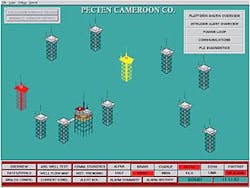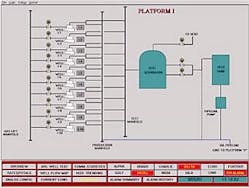Pecten Cameroon Co. (PCC), an operating unit in the Royal Dutch/Shell Group, extended the existing supervisory control and data acquisition (SCADA) infrastructure at offshore Cameroon facilities by integrating software and installing wellhead control valves.
From the upgrade, the company achieved quick and cost effective gas-lift control, troubleshooting tools, and optimization.
To extend the SCADA, Shell R&D integrated the Shell-developed FieldWare software, based on specialized mathematical models and optimization pro cesses, with the existing off-the-shelf system software named Wonderware SCADA, supplied by Invensys PLC, London.
Cameroon facilities
Off Cameroon, PCC currently produces about 30,000 b/d total fluid from about 84 gas-lifted wells and 2 wells with electric submersible pumps (ESPs) that are on 11 platforms.
Each gas-lifted well has a single tubing string, most commonly with 27/8-in. tubing, with three internal-pressure operated gas-lift valves per string, an average producing depth of 4,000 ft, average oil production of 300 bo/d net, 19.6
PCC had installed a commodity SCADA system from Wonderware about 4 years ago to allow operators to monitor real-time wellhead and process data.
During a recent productivity evaluation exercise in Cameroon, the joint PCC and Shell R&D team recognized that the company could more effectively use the Wonderware real-time data for lift-gas control-the challenge was how to do it quickly and without "breaking the bank."
Software development
Recognizing long ago, that real-time wellhead data could be used to operate an oil field more safely and efficiently, Shell has gained extensive experience in real-time optimization and control.
The company realized that with real-time data available, it was best to use it immediately to monitor and control the process from the wellhead to the point-of-sale effectively.
It developed smart applications from scratch, initially for beam pumped wells and subsequently for well surveillance, gas lift, injection, ESP, and well testing.
Previously, operating companies had to build almost every part of a control system themselves-power supplies, instrumentation, telemetry, and SCADA-to get the real-time data and applications to use them effectively.
Today, most of these items are available as off-the-shelf commodities, except for the specialized and industry-specific mathematical models and optimization processes in which the oil company can continue to add value.
These models, developed as the suite of applications known as FieldWare, provide analysis, design, optimization, surveillance, and control for artificially producing and injecting wells.
The software has associated modules for gas lift, ESP, beam pumping, injection, well-test monitoring, control and optimization, and well surveillance. Engineers are currently developing a module for progressive cavity pumps.
FieldWare provides a real-time infrastructure that related technology evolving from R&D can build on and get quickly into operations-PCC's use of the software for gas-lift control is a case-in-point.
Engineers have designed its applications to "drop" into a commodity SCADA, DCS (distributed control system), or historian environment-almost like adding a Microsoft spreadsheet to a Word document.
System upgrade
The traditional approach would have been to remove the Wonderware system and install a new SCADA or DCS system containing the required applications, which would have involved engineering design, system build, installation, test, documentation, and operator training-all expensive and time consuming.
PCC and Shell Global Solutions recognized that a much more elegant solution, however, would be simply to "drop" the FieldWare gas-lift optimization and well surveillance applications into the existing Wonderware SCADA system.
Gas-lift optimization also requires remote control of the wellhead lift-gas injection. The company, therefore, had to install remote actuators as part of the project-all other electronic instrumentation was already in place.
Shell required about a month at its Houston premises to integrate, configure, build, and test the combined system to the satisfaction of PCC operations.
After shipping the software system to Cameroon and installing it, at the same time as the wellhead gas-lift valve actuators, PCC successfully tested the combined hardware and software on location with a gas-lift expert commissioning the combined system for lift-gas control.
Platform operations
Fig. 1 shows the original Wonderware field display. When the system recognizes a well-related problem, the associated platform icon on the display starts to blink.
Clicking on the display platform icon automatically brings-up the associated original Wonderware platform display, which "flashes" the problem well (Fig. 2). Similarly, clicking on the offending well opens a Wonderware panel with an imbedded FieldWare gas-lift display (Fig. 3).
At this point, operations personnel have access to an array of tools to analyze and correct the problem, including heading detection, well low and off alarms, and the ability remotely to adjust the well's gas-lift injection rate.
A well-surveillance module, called FlowMonitor and built into the FieldWare application in addition to the gas-lift module, calculates well production rates in real time from a pressure-drop measurement in the flowline.
PCC has real-time measurements of tubing-head pressure and manifold pressure, which input into the well-surveillance algorithm, calculating the well's rate in barrels per day.
Again, Wonderware does the real-time data acquisition and automatically sends the required data to the well-surveillance module, which calculates the flow rates and provides the result back for display on Wonderware screens.
The combination of a real-time measurement of the well's production and the ability remotely to adjust the amount of gas-lift gas to each well gives the operator a powerful capability to optimize overall production.
Every time an operator adjusts the gas-lift injection rate, he or she can see the effect on the well's production on that well and on all of the wells.
FieldWare's network capabilities provide real-time data to PCC's onshore staff, such as petroleum technologists, without additional cost after installation.
The FieldWare gas-lift module has the capability of continuous closed-loop control, which it achieves by modeling the well's two-phase flow behavior.
It reuses the models in the real-time system remotely to adjust the amount of lift-gas injection into each well for maximum oil production, given the amount of lift-gas available.
Engineers used the same two-phase flow behavior models for the initial gas-lift valve design.
Acknowledgments
The authors thank Shell Pecten Cameroon for the company's support during the project and for permission to publish this article. The authors also thank Shell International for providing gas-lift expert services, which were key to the project's success.
The authors
Ron Cramer works in oil-field automation for Shell Global Solutions, Houston. Previously, he worked for Union Carbide and Polysar in research and process areas, and for Shell International in oil-field automation and production systems. He holds a BS in chemical engineering from Strathclyde University, Glasgow, and an MS in chemical engineering from Waterloo University, Ontario.
Richard Peters directs oil field automation software development for Shell Global Solutions' advanced production management team in Houston. Previous Shell activities include an assignment with CalResources LLC directing production and facilities automation and, earlier, developing artificial intelligence applications for Shell Oil Co. He holds BS degrees in chemical engineering and mineral engineering mathematics from the Colorado School of Mines, Golden.







